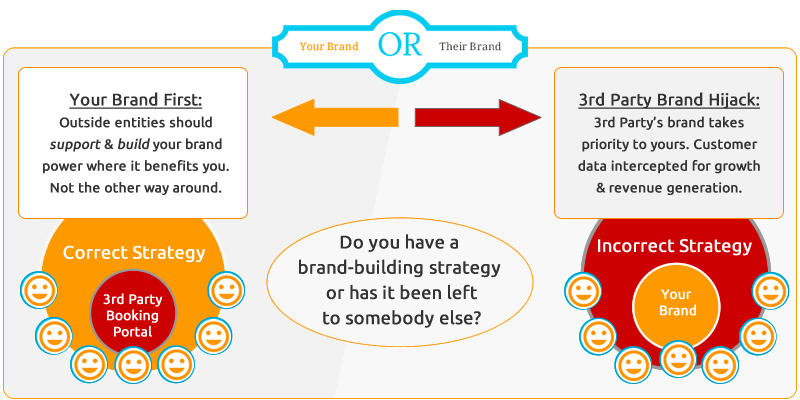Every dime spent is an investment in guest experience and keeping the business profitable. To do this, companies are offering more and more solutions and make some pretty terrific claims about what they can do (us included).
The volume of options and promises can be so mind boggling, it’s easier not to think about it. After all, there are always more pressing matters, an assistant manager just quit, there’s a surprise party of 50 tonight and chef says he will have to 86 the fish special that an email blast just promoted.
Perhaps for a variety of reasons, in this mix, some of the 3rd party systems that are available to build business, market the restaurant and collect data to make decisions on, seemed like the best choice at one time or another. In these cases, it may be worth considering if such strategies. Are they still worth the price tag that comes along with such services?
The business model and “product” connection
Several years ago an observation was made about “free” online services: ‘If you’re not paying for it; you are the product’ (source).
In a world of “free” services and information, this can mean a lot of things. When we’re talking about consumer data, we’re talking billions. In the restaurant industry, quite a few service providers claim they’re the leaders in restaurant marketing. To catch their customers, there’s a tightly packaged proposition offering “free” online reservations, but what is hidden here is the essence of what’s really free, and what the product really is. For these “free” services, what many customers are unaware of is that not only do restaurants pay a hefty bill for these “free” services (many get upset when they discover how much their beloved restaurant pays on their behalf), but they themselves are the commodity. Data about your customers is harvested and sold to support other revenue streams while at the same time you foot the bill.
Slowly over the last fifteen or so years, our industry has gradually surrendered control of it’s own business model by outsourcing essential guest management services to other companies. Interestingly, these companies are now worth billions and restaurant profitability gets slimmer and slimmer. If the business models were in the correct order, restaurants would be enjoying better profitability as well. Think of the shift of wealth that’s gone from the restaurant’s business model to the business model of many publicly traded companies.
Would you outsource your food?
Let’s consider food preparation. What if a restaurant fired their chef, cooks, shut down the walk-ins, sold out their food inventory and let another team of people purchase, prepare and then deliver the food to the restaurant? Is money saved? Sure. Is labor cost reduced? Absolutely. Are profits going to go up? Never.
The loss of control over the food would impact the restaurant’s abilty to prepare food and stay true to it’s mission, it’s own identity and it’s brand. Something organic would be inevitably lost. It’s like pouring a cup of water into a Pinot Noir. It’s still red wine. But it’s ruined.
This example of outsourcing food production is what’s happened in the industry when it comes to restaurant marketing. In this example, the restaurant has forsaken control over it’s brand for the convenience of “not having to do that” and in doing so handed over control of it’s brand to another business model.
Marketing, brand building and customer relationship management is as important as food preparation to a restaurant’s identity. When a restaurant uses 3rd party systems to handle their online reservations or wait list management, which is usually misguidedly sold as “marketing” to justify the high cost, they’re also serving another company’s business model and putting their own into second place.
Who’s brand is first?

Brand control that supports the restaurant’s business model first is not possible under the terms of 3rd party “marketing” systems. The potency of the customer’s experience is unconditionaly diluted. The long term result of what may seem to be a “quick fix” for creating new business reduces profits and ultimately devalues the entire business.
So what’s the answer?
It’s not an easy one. The first step is reclaiming the kind of customer relationships the restaurant industry was born form. Making sure each guest is always “under your roof” – not under someone else’s. If a guest is taken to another website to make an online reservation, they’re now under somebody else’s roof. In an instant that’s brand dilution and dozens of opportunities from what your guest does next is taken from the restaurant because influence of the guest’s actions are now handed over to somebody else.
The answer is in observing the flow of your guest’s footsteps. They should always be influenced to your front door, your website, your Facebook page, your phone number. The second the flow goes the other way, is where the hijack happens.
The answer is protecting your business model first by not allowing any outward flow of your money and your customer data.
Highly successful corrections of misaligned business models can quickly be corrected through brand engineering, the right mindset, the right tools, and a commitment to continued learning (and unlearning).
There are billions flowing out of the industry into Wall Street and there is nothing wrong with that, but as a company that has a mission to serve the restaurant industry first, we’d rather see that money redirected into the hands of restaurant owners. They’ll have more money for better marketing, well deserved pay increases, better product on the menu, or next location.
 |
Whose business model comes first? 2018-01-21 11:46:50

